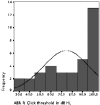Identifying congenital hearing impairment: preliminary results from a comparative study using objective and subjective audiometric protocols
- PMID: 23620637
- PMCID: PMC3631808
Identifying congenital hearing impairment: preliminary results from a comparative study using objective and subjective audiometric protocols
Abstract
To compare objective and subjective protocols assessing hearing loss in young children and evaluate frequency-specific hearing impairment through a comparison between auditory steady state responses (ASSR), auditory brainstem responses (ABR), transient otoacoustic emissions and conditioned orientation reflex responses (COR). Thirty-five hearing-impaired children (20 male and 15 female), aged between 14 months and 4 years, participated in the study. Hearing threshold levels and peripheral auditory function were assessed by measurements of ABR, ASSR, otoacoustic emissions and COR. The analysis of the COR and ASSR variables showed significant correlations in the majority of tested frequencies. The data highlight a characteristic of the COR procedure, which is an underestimation of the hearing threshold in comparison to the ASSR estimate. The data show that the COR threshold assessment follows the pattern of the other two established electrophysiological methods (ABR, ASSR). The correlation analyses did not permit evaluation of the precision of these estimates. Considering that the ASSR variables show a better relationship with ABR (higher correlation values) than COR, it might be advantageous to utilize the ASSR to gain frequency-specific information.
Obiettivo del nostro studio è stato confrontare protocolli di valutazione uditiva oggettivi e soggettivi nei bambini e valutare la perdita uditiva anche in rapporto alle frequenze, mediante il confronto tra i dati ottenuti attraverso l'utilizzo dei potenziali evocati uditivi di stato stazionario (ASSR), i potenziali evocati uditivi del tronco encefalico (ABR), le emissioni otoacustiche (OAE) e l'audiometria a riposte condizionate (COR). Sono stati inclusi in questo studio trentacinque bambini ipoacusici (20 maschi e 15 femmine) di età compresa tra 14 mesi e 4 anni. I valori di soglia uditiva sono stati valutati attraverso l'utilizzo di questi protocolli: ASSR, ABR, OAE e COR. I valori di soglia ottenuti mediante COR e ASSR mostrano una correlazione significativa nella maggior parte delle frequenze testate. Dall'analisi dei dati si è riscontrato che la valutazione della soglia mediante COR segue il modello degli altri due metodi elettrofisiologici (ABR, ASSR). Tuttavia l'analisi di correlazione non permettere una valutazione della precisione di queste stime. Considerando che le variabili ASSR mostrano valori di correlazione più alti con l'ABR rispetto al COR, potrebbe essere vantaggioso utilizzare le ASSR per ottenere informazioni di soglia più precise, anche in merito alle diverse frequenze.
Keywords: Auditory brain-stem responses (ABR); Auditory steady state responses (ASSR); Conditioned orientation reflex (COR); Otoacoustic emissions (OAE); Sensorineural hearing loss.
Figures




Similar articles
-
Evaluation of Speed and Accuracy of Next-Generation Auditory Steady State Response and Auditory Brainstem Response Audiometry in Children With Normal Hearing and Hearing Loss.Ear Hear. 2018 Nov/Dec;39(6):1207-1223. doi: 10.1097/AUD.0000000000000580. Ear Hear. 2018. PMID: 29624540 Free PMC article.
-
COMPARISON OF HEARING THRESHOLD ESTIMATION USING AUDITORY STEADY STATE RESPONSES AND BRAINSTEM AUDITORY EVOKED POTENTIALS IN CHILDREN.Acta Clin Croat. 2019 Dec;58(4):701-708. doi: 10.20471/acc.2019.58.04.17. Acta Clin Croat. 2019. PMID: 32595255 Free PMC article.
-
Comparison of ASSR and frequency specificity ABR induced by NB CE-Chirp for prediction of behavioral hearing thresholds in children with conductive hearing loss.Int J Pediatr Otorhinolaryngol. 2024 Jan;176:111826. doi: 10.1016/j.ijporl.2023.111826. Epub 2023 Dec 14. Int J Pediatr Otorhinolaryngol. 2024. PMID: 38109806
-
[On possible causes of discrepancy between the results of auditory brainstem responses (ABR) and auditory steady-state responses (ASSR) recordings].Vestn Otorinolaringol. 2025;90(1):64-68. doi: 10.17116/otorino20259001164. Vestn Otorinolaringol. 2025. PMID: 40099337 Review. Russian.
-
Association of Audiometric Measures with plasma long chain polyunsaturated fatty acids in a high-fish eating population: The Seychelles Child Development Study.Neurotoxicology. 2020 Mar;77:137-144. doi: 10.1016/j.neuro.2020.01.005. Epub 2020 Jan 23. Neurotoxicology. 2020. PMID: 31982419 Free PMC article. Review.
Cited by
-
Results of hearing screening of school-age children in Bishkek, Kyrgyzstan.Prim Health Care Res Dev. 2020 Jun 10;21:e18. doi: 10.1017/S1463423620000183. Prim Health Care Res Dev. 2020. PMID: 32517843 Free PMC article.
-
A Retrospective Evaluation to Assess Reliability of Electrophysiological Methods for Diagnosis of Hearing Loss in Infants.Brain Sci. 2022 Jul 20;12(7):950. doi: 10.3390/brainsci12070950. Brain Sci. 2022. PMID: 35884756 Free PMC article.
-
Hearing threshold estimation by auditory steady state responses (ASSR) in children.Acta Otorhinolaryngol Ital. 2018 Aug;38(4):361-368. doi: 10.14639/0392-100X-1463. Acta Otorhinolaryngol Ital. 2018. PMID: 30197427 Free PMC article.
-
Newborn hearing screening in the Campania region (Italy): early language and perceptual outcomes of infants with permanent hearing loss.Acta Otorhinolaryngol Ital. 2013 Dec;33(6):414-7. Acta Otorhinolaryngol Ital. 2013. PMID: 24376298 Free PMC article.
-
A convolutional neural network model detecting lasting behavioral changes in mice with kanamycin-induced unilateral inner ear dysfunction.Heliyon. 2024 Oct 4;10(19):e38938. doi: 10.1016/j.heliyon.2024.e38938. eCollection 2024 Oct 15. Heliyon. 2024. PMID: 39435078 Free PMC article.
References
-
- Parving A. Prevalence of congenital hearing impairment and risk factors. Neonatal hearing screening. In: Grandori F, Lutman M, editors. The European Consensus Development Conference on Neonatal Hearing Screening. Milan: 1998. pp. 6–10.
-
- Moeller MP. Early intervention and language development in children who are deaf and hard of hearing. Pediatrics. 2000;106:43–51. - PubMed
-
- Hayes D. Newborn hearing screening: selected experience in the United States. Scand Audiol. 2001;30(Suppl 53):29–32. - PubMed
-
- Yoshinaga-Itano C, Sedey AL, Coulter BA, et al. Language of early and later-identified children with hearing loss. Pediatrics. 1998;102:1168–1171. - PubMed
-
- Apuzzo ML, Yoshinaga-Itano C. Early identification of infants with significant hearing loss and the Minnesota Child Development Inventory. Semin Hear. 1995;16:124–139.
Publication types
MeSH terms
LinkOut - more resources
Full Text Sources
